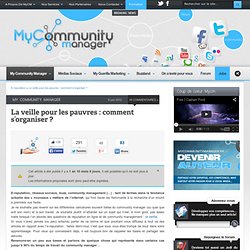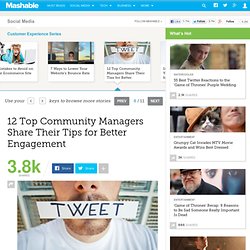

La veille pour les pauvres : comment s’organiser ? Cet article a été publié il y a 1 an 10 mois 9 jours, il est possible qu’il ne soit plus à jour.

Les informations proposées sont donc peut-être expirées. E-reputation, réseaux sociaux, buzz, community management (…) : tant de termes dans la tendance actuelle des « nouveaux » métiers de l’internet, qui font baver les flemmards à la recherche d’un boulot à première vue facile.Je ne souhaite pas revenir sur les différentes caricatures souvent faites du community manager (ou quel que soit son nom) et à son travail. Je souhaite plutôt m’attarder sur un sujet qui n’est, à mon goût, pas assez traité lorsque l’on aborde des questions de réputation en ligne et de community management : la veille.Si vous n’avez jamais (ou peu) entendu parler de ce terme et que pourtant vous diffusez à tout va des articles en rapport avec l’e-reputation : faites demi-tour, c’est que vous vous êtes trompé de bout dans votre apprentissage. 5 Community Types Brands Must Choose From. By David Spinks on Apr 25, 2012.

Trust the Curators. Image courtesy of verbeeldingskr8, Creative Commons If you do anything professionally related to online technology, you understand the immense amount of data you need to sort through daily.

There are the daily content roundups, blogs to read, Facebook posts and to check, tweets to scroll through, and news sites. That doesn’t include whatever else arrives in your inbox. I literally cannot keep up with all that I want to know about social media technology and its use for engagement, fundraising and advocacy. Comment tenir informées les personnes qui aiment ma page par courrier électronique ? - Facebook Aide. 7 Reasons to Rethink Your Blogging Strategy: New Research. Is your business working with bloggers?

Do you blog? This article examines new research that shows blogging is here to stay. Like many social media tools, blogs have seen a steady increase in numbers and influence over the last several years. Note the growth charted by Invesp. On Dec. 2, 2011, that number was 178,637,835 (according to BlogPulse). Number of Blogs Grows 14 million blogs were added since July 2011 (as of 12/2/2011). If people are adding nearly 3 million blogs per month, surely this is a tool worth understanding and maximizing. In this report, bloggers fall into one of five categories: ***Please note that Technorati’s data is heavily skewed by the presence of 60% hobbyist bloggers—people who blog as a way to express themselves or influence their community, but don’t seek to make money.
. #1: Bloggers are young, educated and experienced Bloggers come from all over the world and span the age range. Nearly 60% of bloggers are between the ages of 25 and 44. Bloggers are highly educated. 10 Tips for Creating a Social Media Policy for Your Business. Policy.

Creating a Social Media Strategy: The Secret Sauce. Image courtesy of fotologic, Creative Commons license Yesterday, I had the opportunity to offer a workshop on the topic of creating a social media strategy to a group of budding entrepreneurs.

It’s a big, meaty topic, and no two strategies are ever developed in the same way. Over the years, I’ve developed a methodology of what goes into strategy development, and focused on that methodology for the workshop. There are four elements to developing a social media strategy: evaluating current organizational assets, researching competitors (and comparables), choosing appropriate channels for ongoing participation, and measurement. I might add developing online campaigns (as relevant) to that mix. Keeping It Real: Personal Boundaries in Online Community Management at SXSW. I had the privilege of joining three seasoned social media community managers on the “Personal/Personnel Policy: Social Media Boundaries” panel at South By Southwest this year.

Vanessa Rhinesmith (Director of Outreach at Start Some Good), Jess Main (Director of Operations at National Center for Media Engagement), Amy Sample Ward (Membership Director at NTEN) and I presented examples of how we have negotiated the boundary between personal and professional involvement in social media. 12 Top Community Managers Share Their Tips for Better Engagement. Engagement is one of the most talked about metrics for ROI.

Some argue that the raw number of "Likes", comments and retweets don't mean anything. Instead, they point to a fans' level of investment, loyalty and engagement to determine whether social media is "paying off. " A community manager — or social media manager or brand manager, etc. — is responsible for growing this community, providing interesting content and increasing engagement, which should ultimately lead to increased revenue. How to Strategically Dominate the Facebook News Feed. Getting someone to click “Like” on your Facebook Page is only the first step toward building a thriving community—because few (if any) of your fans will return to your Page by typing in its URL.

Instead, it’s up to you to engage them with timely and consistent updates that appear in their News Feeds. But this is exactly where most brands fail. They grow their fan numbers, but engagement is low—which means fewer clicks, countless lost leads and zero marketing momentum. High engagement, on the other hand, is the secret sauce for Facebook marketing. It’s how big brands stay top-of-mind with prospects. Each time your fans engage with your Page, you get exposure in the Ticker. But the opposite is also true.